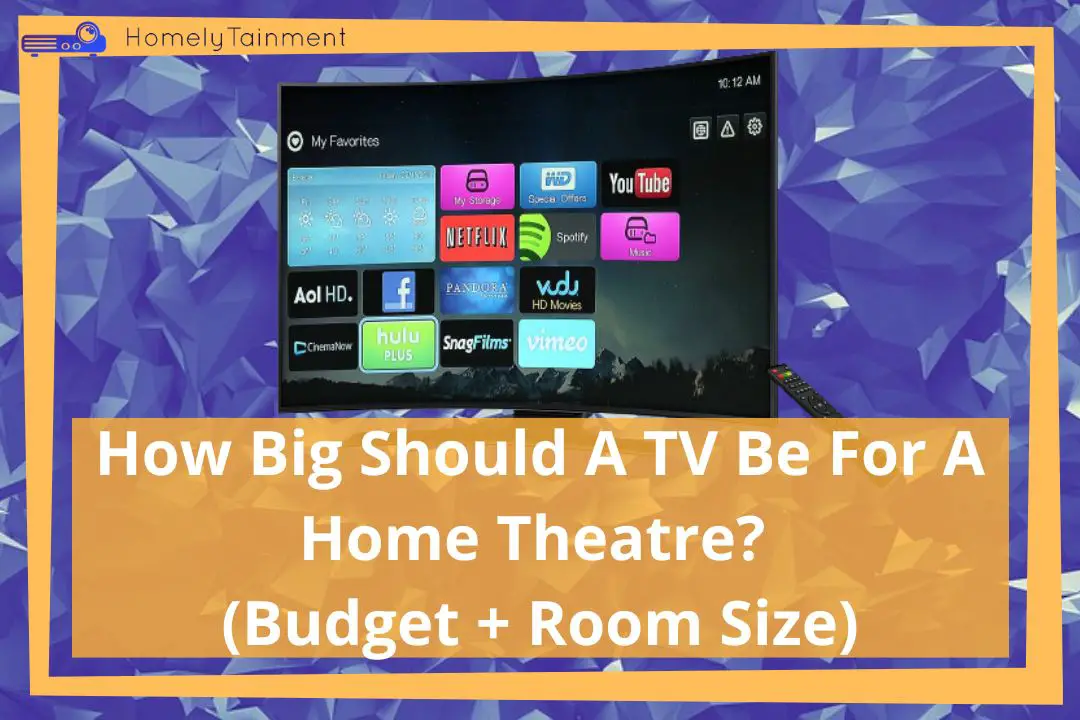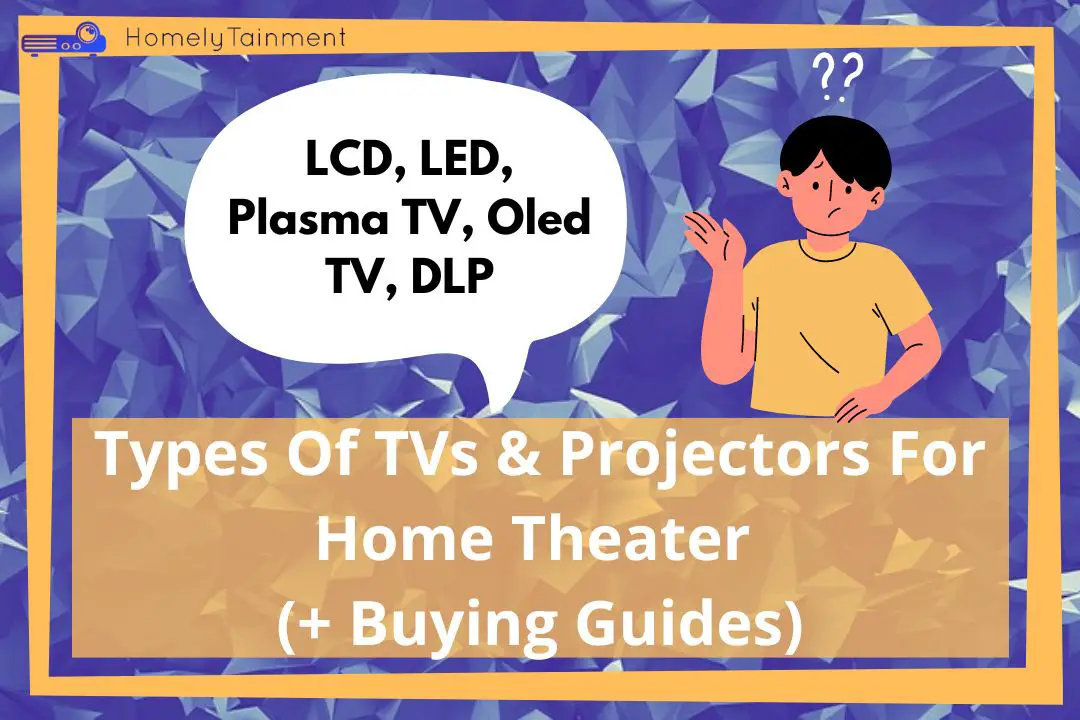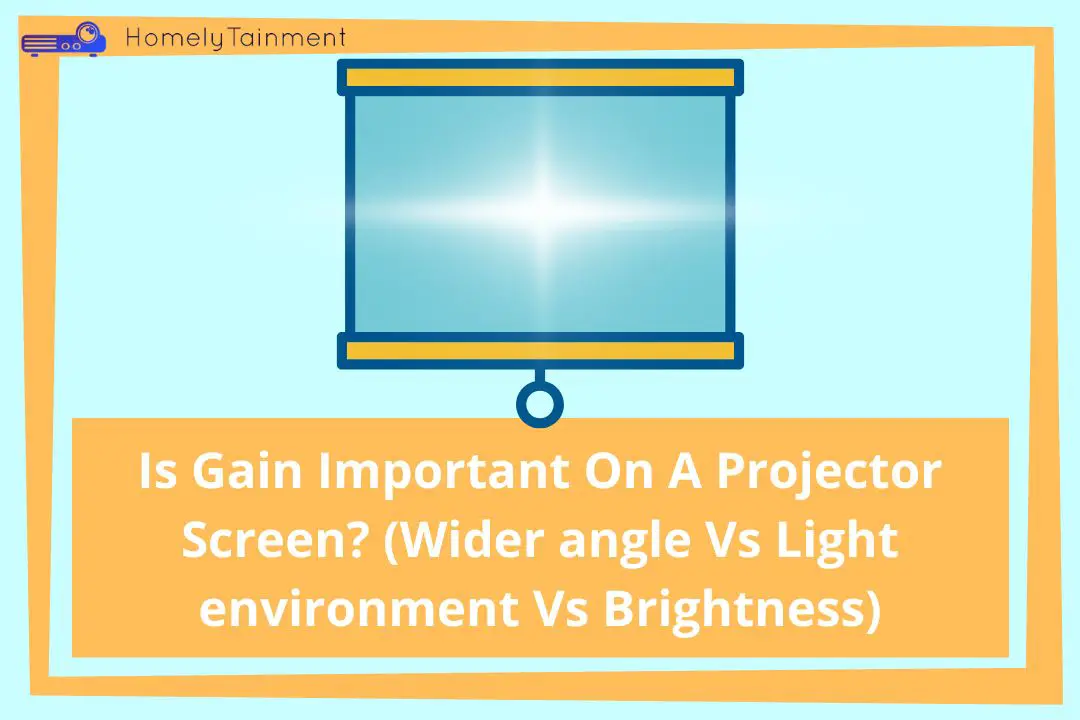
Homelytainment earn commissions (at no additional cost to you) if you purchase products from retailers after clicking on a link from our site.
A viewing distance is as much as important as buying a higher resolution TV or a projector, surround sound speakers, or soundproofing your home theater system. It can make or ruin the theater experience. That’s why pay special attention to it.
Now that you have got a good quality TV/projector screen, or you are considering buying one. You will have this question on your mind. What is the best viewing distance for a home theater screen both for projector & TV?
At A Glance: As a general rule of thumb, for 4K and 8K projector/TV screens multiply their vertical size by 1.5 times its size and the result will be a viewing distance, for 720p and 1080p multiply by 3, and for lower than that multiply by 6 times.
To know why different distances for different screen resolutions, read the below article
The viewing distance is related to the vertical size of the screen but the picture quality plays a role too.
To apply this rule. If your TV or projector screen is 4k or 8k then you can simply sit from a distance that is 1.5 times the vertical screen size. If your 4k screen is 65 inches then you should sit at a distance of 48 inches approximately.
Keep reading to learn how to mine the vertical screen size value and calculate the viewing distance for your screen size in seconds. I will also answer the most important related questions.
Viewing Distances & Screen Sizes Tables
For your convenience, here is the comparison of each screen size with its viewing distance.
The below values are calculated for the most used TV and projector screen sizes. You can follow the viewing distance of the TV for the projector or vice versa. Because they have the same resolution.
Viewing Distance For TV Screen Sizes
The below table has the values for the most used TV sizes. The (16:9) is the most common aspect ratio used in the home theater.
| TV Screen Size diagonally (16:9) | 4K/8K TV Viewing Distance | 1080p/720p TV Viewing Distance | Lower Resolutions TV Viewing Distance |
| 32 inches | 23.5 inches (1.9 ft) | 47.1 inches (3.9 ft) | 94.2 inches (7.8 ft) |
| 45 inches | 34 inches (2.8 ft) | 64 inches (5.3 ft) | 133 inches (11 ft) |
| 50 inches | 37 inches (3 ft) | 74 inches (6.1 ft) | 147 inches (12.2 ft) |
| 55 inches | 41 inches (3.4 ft) | 81 inches (6.7 ft) | 162 inches (13.5 ft) |
| 60 inches | 44 inches (3.6 ft) | 89 inches (7.4 ft) | 177 inches (14.7 ft) |
| 65 inches | 48 inches (4 ft) | 96 inches (8 ft) | 192 inches (16 ft) |
| 75 inches | 56 inches (4.6 ft) | 111 inches (9.2 ft) | 221 inches (18.4 ft) |
| 85 inches | 63 inches (5.2 ft) | 126 inches (10.5 ft) | 251 inches (20.9 ft) |
Viewing Distance For Projector Screen Sizes
The below table has the values for the most used projector screen sizes.
| Projector Screen Size Diagonally (16:9) | 4K/8K Projector Viewing Distance | 1080p/720p Projector Viewing Distance | Lower Resolutions Projector Viewing Distance |
|---|---|---|---|
| 95 inches | 70 inches (5.8 ft) | 140 inches (11.6 ft) | 280 inches (23.3 ft) |
| 100 inches | 73.5 inches (6.1 ft) | 147 inches (12.2 ft) | 294 inches (24.5 ft) |
| 105 inches | 78 inches (6.5 ft) | 155 inches (12.9 ft) | 309 inches (25.7 ft) |
| 115 inches | 85 inches (7 ft) | 170 inches (14.1 ft) | 339 inches (28.2 ft) |
| 120 inches | 87.7 inches (7.3 ft) | 174.9 inches (14.5 ft) | 352.8 inches (29.4 ft) |
| 135 inches | 100 inches (8.3 ft) | 199 inches (16.5 ft) | 398 inches (33.1 ft) |
| 145 inches | 107 inches (8.9 ft) | 214 inches (17.8 ft) | 427 inches (35.5 ft) |
| 150 inches | 110.2 inches (9.1 ft) | 220.5 inches (18.3 ft) | 441 inches (36.7 ft) |
| 200 inches | 127.5 inches (10.6 ft) | 294.3 inches (24.5 ft) | 588.6 inches (49 ft) |
Are these values in the tables backed by any institution or authority?
The values in both of the tables are compliant with SMPTE standards guidelines. But their standard for the viewing distance is not simple like this much inches distance for this resolution. They have only provided the angle for every type of resolution.
The problem with angles is that we are not born mathematicians. That’s why I converted it to a simple method that involves only a two-step calculation method that a 7-year-old can do easily.
You will know how my calculations comply with SMPTE standards after you read this guide completely. You will also learn the 2 steps method.
Other viewing measures such as viewing angle, mounting of the screen, and throw ratio. These values can together break or make your screen viewing experience. Read this article for these additional values to super fire up your theater experience altogether.
Want to know which size of screen your home theater can accommodate? Calculate through this cool home theater screen size calculator that is designed by my talented team.
How Do You Calculate Viewing Distance? (The values in the above tables)

As we all know, TVs and projector screens in the market are measured by their diagonal. Like 65, 75, or 85 inches of screen. In this case. How to find its vertical screen size and then divide it with my recommended value and find the viewing distance for it?
Well, I have a simple two-step process for you.
Get the 75 inches diagonal value of the TV or projector screen. Don’t search for diagonal values as they measure the TV in diagonal already.
The 75 inches TV, diagonal value is 75. Head over to this screen measuring tool here with this value and follow the below steps.
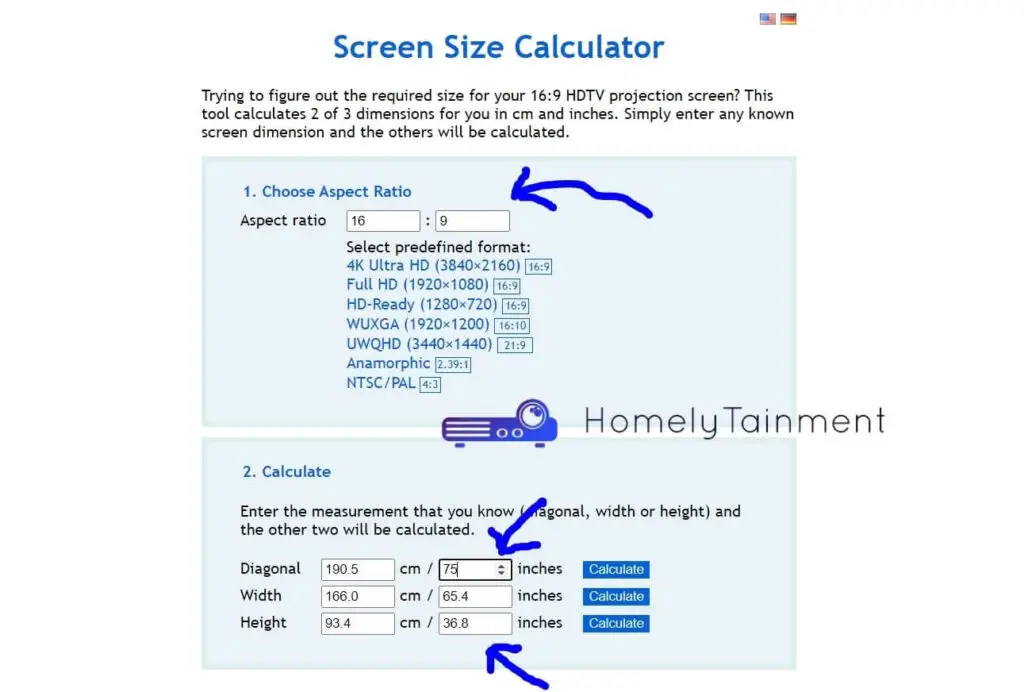
- Select the aspect ratio of 16:9 in the tool above. Home theater screens are mainly available in this ratio.
- Put the diagonal value of 75 in the diagonal section
- You will get the height value of that TV, which will be 36.8
- Now, multiply this value by 1.5 and you get a 55 value
- This new value is the viewing distance for you in inches
- Everything is so damn simple now.
What About a Screen Viewing Angle of 30° provided by SMPTE?
The reputable organization of SMPTE recommends that you must watch your screen at 30-degree viewing angles.
Now this will get more confusing for you to do a degree calculation for your home theater screen.
As we follow the screen height calculation formula above. That will pretty much work the same for satisfying this SMTP recommendation viewing angle degree.
Simply go and multiply the height of the screen by 1.5 for 4K resolution. The desired value will be your viewing distance. At this distance, you will automatically get a degree value that will be near this 30-degree angle.
After angles and distances, you can try my these 13 theater experience improving tips for the best experience possible.
Other Things To Take Into Consideration For The Best Experience
Screen Mounting Position
This one value completely depends on your experience. That’s why we will identify the perfect spot for the mounting position according to your comfort.
You mustn’t select a very high spot for mounting because then you will experience strain in your neck.
- Sit on the Sofa that you have installed in the middle of the room and the assistant should be standing along the wall where you will mount the TV or the projector screen
- Now closely observe different spots at the front of your wall
- Where you feel that your neck and the whole body are comfortable
- Point at the spot and your assistant should mark that spot with the pen
- Now this is your spot for the screen mounting
Resolution And Pixels
Other things are resolution and pixels.
No matter how correctly you calculate the viewing angle and viewing distance from the screen. If your resolution and pixels do not support you, then all these calculations will go in vain.
If your TV is not providing you with a higher pixel density of pixels across the screen then you will have to watch it from a distance in which your eyes don’t notice individual pixels.
But if the TV screen provides you with a lot of pixels across the screen and a very tiny size of each pixel then you can watch it from a lesser distance than the lower-density pixel TVs.
But don’t worry too much about this pixel density because modern TV brands do provide a higher density of pixels. Like many new 8K TVs & projectors provides 33 million pixels across the screen. But I don’t recommend 8K screens because they are expensive and there is not much 8K content available right now. It will be in the future. That’s why now the 4K is the best.
But you must confirm higher pixel density before buying any TV.
Another thing is resolution. Never settle down for less than the 4K resolution for both TV and projector. This will give you the best picture quality from a lesser distance without noticing any individual pixels.
Final verdict:
This formula for calculating the perfect viewing distance works fine when you thrive for the 4k resolution and good throw distance ratio and lumens for the projector too.
This will instantly satisfy the formula for your theater room. Otherwise, you will have difficulties with adjustments.
Screen Size And Viewing Distance Chart (Downloadable)
This chart is created for those who want a more handy form of it. All values in this chart are calculated by SMPTE standards. You can confidently follow these values.
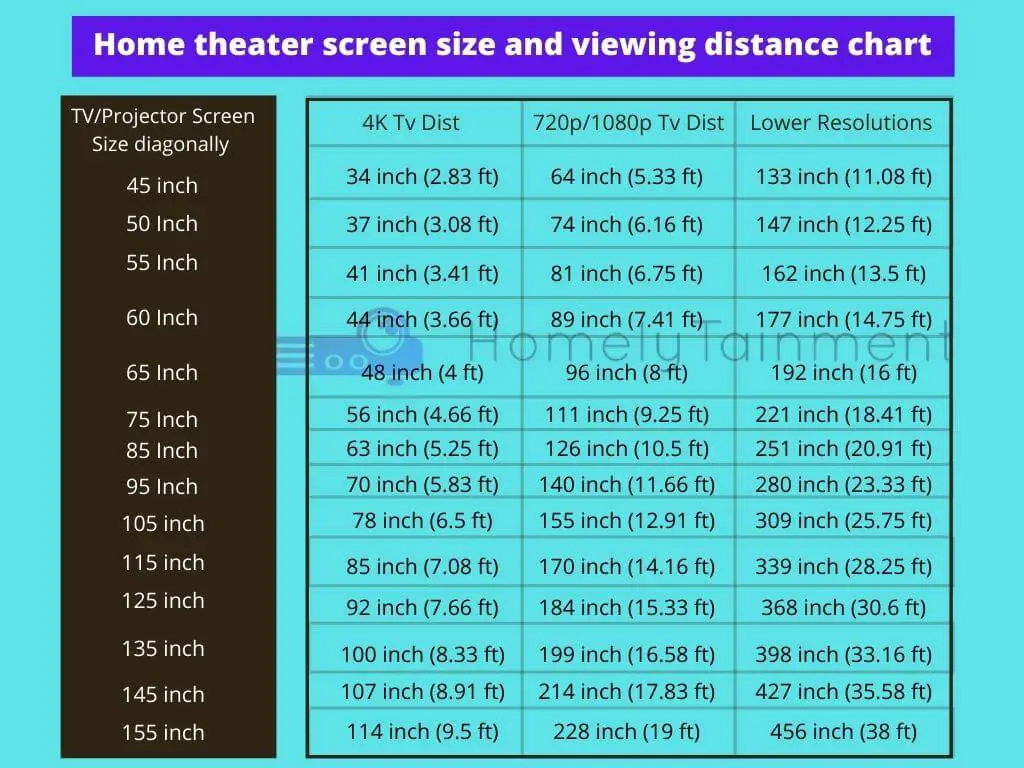
FAQs
How far should I sit from my TV for gaming in the home theater?
If you are considering gaming for your home theater room, then the calculation for its viewing distance will be a little different because games rely on latency and frame refresh rates.
You will have to sit from the screen at a distance that must be 2.5 times the diagonal size of the screen.
The above formula that we discussed is for movies and other videos like sports, and it is calculated by the vertical screen size.
Is it bad to sit too close to the TV?
Well, it is not harmful to sit closer to the TV. It will not damage your eyes, but it will strain your eyes. Your eyes will feel the strain quickly. If you do this for a few years. Your eyesight will be strong at shorter distances but weak for longer distances seeing.
It is recommended to follow the viewing distance formula above for this. But still, take breaks after year 2 hours and go out. Don’t binge-watch for the whole day straight in a row.
Helpful Resources For The FAQs To Read More
- A projector-throw ratio plays a very important role in the distance from the screen. You can read my this best short-throw projector review. (Resource for the first answer)
- This was my opinion, learn more about it from this Reddit discussion. (Resource for the second answer)
- This was my opinion, learn more about it on the AAO.org blog. (Resource for the third answer)

